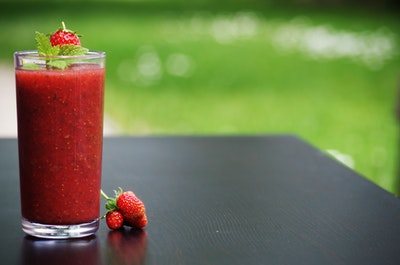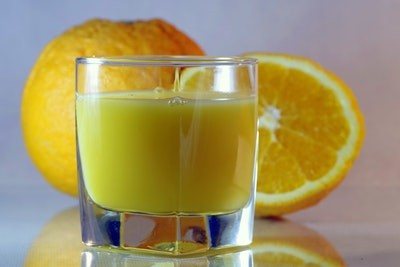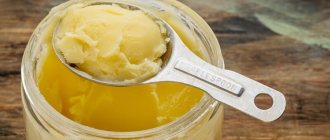Juices in other servings:
49
0.49
| Qty | A portion | Calories | In the counter |
| 100 g | 49 | ||
| 1 g | 0.49 | ||
| 122 | 1 cup = 249.45g | 122 | |
| 15 | 1 fl oz = 31.23g | 15 | |
| 123 | 1 glass = 250g | 123 | |
| 50 | 100 ml. = 103g | 50 |
Use in cooking
Due to its taste, this product is widely used in cooking. There are many options for using apple juice. It is usually added to various mousses and jellies, sorbets, fruit drinks and jelly, as well as to all kinds of gravies and sauces. Jelly from this drink is prepared both with and without gelatin. It is recommended to mix apple drink with various vegetable and fruit juices. Combinations of fresh apple juice with carrot or beet juice will be very useful. Celery also has considerable value, especially freshly squeezed juice from this plant, mixed with natural apple juice.
This drink is often used as a base for making cocktails. The most popular today are “Apple Whiskey” and “Apple Martini”. Mulled apple wine, which can be prepared with or without alcohol, will be very beneficial for health, especially during colds and cold weather. In summer, a juice cocktail with ice cream is very refreshing. And if you add a little fresh juice to your tea, it will sparkle with new colors and captivate you with its interesting taste.
At home, you can also prepare the famous apple liqueur - Calvados. To do this, the fresh juice must be placed in a dark place for a day, then filtered through gauze. Subsequent distillation of the product will turn it into pure apple moonshine. To obtain Calvados, you need to age the drink in oak barrels to preserve the tart woody taste and aroma. To do this, moonshine is usually diluted with water to 45 degrees. In the absence of barrels, you can use glass containers with wooden lids. You need to fill them with moonshine, close them tightly and leave them to infuse in a dark, cool place for at least six months. After this, the infused Calvados must be filtered through several layers of gauze and bottled for subsequent storage.
The fermented product is often used to prepare strong alcoholic drinks, cider, which is also called apple wine, kvass, and vinegar. Apple juice mash is used to produce homemade moonshine.
Lenten cupcake with apple juice
During the fasting period, you often crave sweets. In this case, you can prepare a Lenten cake. For this you will need:
- sugar - 1 tbsp. l.;
- apple juice - 250 ml;
- olive oil - half a tablespoon;
- walnuts - 250 g;
- soda - half a teaspoon;
- flour - 2 tbsp. l.;
- apple - 1 pc.;
- apricot jam - 2 tbsp. l.;
- salt.
Fry the nuts in a dry frying pan, stirring frequently, then chop and add to the mixture of sugar, vegetable oil and salt. Pour baking soda into the apple juice and add the foaming liquid to the mixture. Send finely chopped apple and sifted flour there. Pour the resulting dough into the mold and bake at 180 degrees for 50 minutes. Grease the cake with heated jam at the end of cooking.
“Juice” - in more detail:
- Apple juice
- Green apple juice
- Concentrated apple juice
- Apple juice without sugar
- Orange-pineapple juice
- Orange-grapefruit juice
- Freshly squeezed orange juice
Calorie table for juices and compotes

© whitestorm — stock.adobe.com
Share:
If a person is watching his figure, he should definitely include what he drinks in his caloric intake. Everyone knows this, but many neglect this fact, because “one glass of juice will do nothing.” This is fundamentally wrong, because many juices contain sugar. That is why the table of calorie content of juices, compotes, nectars, including the content of proteins, fats and carbohydrates, comes to the rescue. So, you can create a diet that is correct in terms of calories, taking into account all the nuances.
| Drink name | Calorie content, kcal | Proteins, g per 100 g | Fats, g per 100 g | Carbohydrates, g per 100 g |
| Apricot compote | 85 | 0.5 | 0.0 | 21.0 |
| Apricot juice | 38 | 0.9 | 0.1 | 9.0 |
| Quince compote | 79 | 0.4 | 0.0 | 20.0 |
| Quince juice | 45 | 0.5 | 0.0 | 10.6 |
| Pineapple compote | 71 | 0.1 | 0.1 | 14.0 |
| Pineapple nectar | 54 | 0.1 | 0.0 | 12.9 |
| Pineapple juice | 48 | 0.3 | 0.1 | 11.4 |
| Orange nectar | 43 | 0.3 | 0.0 | 10.1 |
| Orange juice | 36 | 0.9 | 0.2 | 8.1 |
| Watermelon juice | 38 | 0.6 | 0.1 | 5.9 |
| Banana juice | 48 | 0.0 | 0.0 | 12.0 |
| Birch juice | 24 | 0.1 | 0.0 | 5.8 |
| Elderberry juice | 27 | 1.1 | 0.2 | 5.1 |
| Grape compote | 77 | 0.5 | 0.0 | 19.7 |
| Grape juice | 54 | 0.3 | 0.0 | 14.0 |
| Cherry compote | 99 | 0.3 | 0.2 | 24.0 |
| Cherry nectar | 50 | 0.1 | 0.0 | 12.0 |
| Cherry juice | 47 | 0.7 | 0.0 | 10.2 |
| Pomegranate juice | 64 | 0.3 | 0.0 | 14.5 |
| Grapefruit nectar | 44 | 0.2 | 0.0 | 10.4 |
| Grapefruit juice | 30 | 0.9 | 0.2 | 6.5 |
| Pear compote | 70 | 0.2 | 0.0 | 18.2 |
| Pear nectar | 37 | 0.1 | 0.1 | 8.8 |
| Pear juice | 46 | 0.4 | 0.3 | 11.0 |
| Guava juice | 57 | 0.1 | 0.1 | 13.9 |
| Strawberry juice | 41 | 0.0 | 0.0 | 10.0 |
| Cherry juice jelly | 78 | 0.2 | 0.0 | 18.9 |
| Cranberry jelly | 53 | 0.0 | 0.0 | 13.0 |
| Kissel from dried apricots | 54 | 0.4 | 0.0 | 12.9 |
| Plum jam jelly | 63 | 0.1 | 0.0 | 15.5 |
| Dried apple jelly | 66 | 0.1 | 0.0 | 16.3 |
| Apple jelly | 97 | 0.1 | 0.1 | 23.7 |
| Strawberry juice | 31 | 0.6 | 0.4 | 7.0 |
| Cranberry juice | 46 | 0.4 | 0.3 | 11.0 |
| Dried fruit compote without sugar | 60 | 0.8 | 0.0 | 14.2 |
| Lime juice | 25 | 0.0 | 0.0 | 8.2 |
| Lemon juice | 16 | 0.9 | 0.1 | 3.0 |
| Raspberry juice | 100 | 0.8 | 0.0 | 24.7 |
| Mango juice | 54 | 0.0 | 0.0 | 13.5 |
| Tangerine compote | 69 | 0.1 | 0.0 | 18.1 |
| Tangerine juice | 36 | 0.8 | 0.3 | 8.1 |
| carrot juice | 28 | 1.1 | 0.1 | 6.4 |
| Carrot juice “Golden Rus'”, exotic | 44 | 0.0 | 0.0 | 11.0 |
| Passion fruit nectar | 41 | 0.2 | 0.0 | 9.8 |
| Pumpkin nectar “Udachny” | 48 | 0.0 | 0.0 | 12.0 |
| Nectarine nectar | 53 | 0.1 | 0.0 | 12.8 |
| Nectarine juice | 37 | 0.4 | 0.0 | 8.6 |
| Sea buckthorn juice | 52 | 0.6 | 3.4 | 4.3 |
| Cucumber juice | 14 | 0.8 | 0.1 | 2.5 |
| Peach compote | 78 | 0.5 | 0.0 | 19.9 |
| Peach nectar | 38 | 0.2 | 0.0 | 9.0 |
| Peach juice | 40 | 0.9 | 0.1 | 9.5 |
| Beet juice | 42 | 1.0 | 0.0 | 9.9 |
| Plum compote | 96 | 0.5 | 0.0 | 23.9 |
| Plum nectar | 46 | 0.1 | 0.0 | 11.0 |
| Plum juice | 39 | 0.8 | 0.0 | 9.6 |
| Kiwi juice | 41 | 0.0 | 0.3 | 10.0 |
| Noni juice | 44 | 0.1 | 0.3 | 10.0 |
| Juice vegetable mixture “Golden Rus'” | 20 | 0.0 | 0.0 | 5.0 |
| Juice vegetable mixture “Tonus Active” | 25 | 0.0 | 0.0 | 6.2 |
| Vegetable juice “Mr. Vegetable” with salt, sweet pepper and garlic | 20 | 0.0 | 0.0 | 5.0 |
| Papaya juice | 51 | 0.4 | 0.1 | 13.3 |
| Parsley juice | 49 | 3.7 | 0.4 | 7.6 |
| Celery juice | 31 | 0.7 | 0.3 | 4.8 |
| Tomato juice | 21 | 1.1 | 0.2 | 3.8 |
| Tomato juice “J-7” with pulp | 22 | 0.2 | 0.0 | 5.3 |
| pumpkin juice | 38 | 0.0 | 0.0 | 9.0 |
| Cherry compote | 78 | 0.5 | 0.0 | 19.9 |
| Blueberry juice | 38 | 0.0 | 1.0 | 8.0 |
| Chokeberry juice | 32 | 0.1 | 0.0 | 7.4 |
| Blackcurrant compote | 58 | 0.3 | 0.1 | 13.9 |
| Blackcurrant juice | 40 | 0.5 | 0.0 | 7.9 |
| Rosehip juice | 70 | 0.1 | 0.0 | 17.6 |
| Apple compote | 85 | 0.2 | 0.0 | 22.1 |
| Apple nectar | 41 | 0.1 | 0.0 | 10.0 |
| Apple juice | 42 | 0.4 | 0.4 | 9.8 |
You can download the full table so that it is always at hand here.
Rate the material
Share:
Composition of nutrients, BJU
Juices
| For quantity: 100 grams | ||
| Calories — 49 | Calories in fat - 1 | |
| BJU | ||
| Total fat content | 0.14g | |
| Saturated | 0.02g | |
| Polyunsaturated | 0.04g | |
| Monounsaturated | 0.02g | |
| Cholesterol | 0mg | |
| Total carbohydrate content | 11.82g | |
| Dietary fiber | 0.3g | |
| Sugar | 10.79g | |
| Squirrels | 0.41g | |
| Vitamins and microelements | ||
| A - 6.39 µg | C - 24.4 mg | |
| B-6 – 0.04 mg | B-12 - 0mcg | |
| D - 0mcg | E - 0.15 mg | |
| Calcium 20 µg | Iron 0.26 mg | |
| Magnesium 10.07 mg | Zinc 0.08 mg | |
| Potassium 153 mg | Sodium 4mg | |
Distribution of calories for BJU:Carbohydrates (95%) Fats (2%) Proteins (3%) | ||
Technological process, selection and storage of juice
A significant part of the apple juice that can be found on supermarket shelves is produced industrially. For this purpose, special equipment is used, such as a squeezing press. It can be of several types: hydraulic, screw or industrial (for the production of large volumes of products). Manufacturing technology includes pressing and pasteurization process. For storage, aseptic packaging of the product is used. Sometimes juice is obtained through the process of restoring it from concentrate. To make it transparent, it is necessary to ensure that the particles settle. Then the product is clarified and purified or filtered. Juice can be clarified in several ways [6]:
- biochemical;
- physico-chemical;
- physical.
Today, a large quantity of this product is presented in various packaging: glass, plastic, bags or boxes. Each such product may vary in composition and method of preparation.
When choosing a product, you should pay attention to its content, organoleptic characteristics and date of manufacture. It is better to choose a product in a glass container - then you can judge it by its appearance. This juice is stored for about two years, and in a tetra pack for 1 year. Cardboard packaging is the best protection from sunlight, which means more vitamins and nutrients are stored there.
Which is better: the product in a can or fresh

The answer to this question is quite obvious at first glance. When studying this topic in detail, some nuances arise.
Exotic fruits from supermarkets boast an ideal appearance: they were picked while still “green” and ripened during transportation.
The amount of nutrients in such conditions is noticeably reduced, which means that fresh juice from such fruits will not be as healthy as possible.
At the same time, raw materials for packaged juices are always processed at the collection sites; for this purpose, the most ripe and high-quality fruits are selected. Store-bought juice is preserved through special multi-layer packaging and slight pasteurization.
If you are confident in the quality of fruits and vegetables, it is better to prepare homemade fresh juice; in all other cases, juice from packages will be an excellent source of vitamins.
Expert advice

R. Lustig, professor of medicine at the University of California
If you have a choice: fruit or similar fresh juice, always choose the first. You won't be able to eat too much fruit, which means you'll provide your body with less natural sugar (for example, 500 ml of juice is more than 1 kilogram of ripe oranges).
Another significant disadvantage of juice is the lack of plant fiber in the composition. If you eat whole fruits, plant fiber creates a protective layer in the intestines through which sugar penetrates much more slowly and the liver is not as actively stressed. Drinking a glass of juice can overload your liver.
L. Vergatus, personal trainer, nutritionist
The consumption of a variety of fresh juices should be moderate even in a normal diet, not to mention the diet of a person losing weight. In this case, it is better to choose low-calorie juices from vegetables, fruits, and their combinations.
You should not drink more than one glass per day. For variety and extra fiber in your diet, you can make a smoothie by chopping and blending whole pieces of fruit.
N. Fadeeva, nutritionist, Doctor of Medical Sciences
The benefits of freshly squeezed juices are obvious - they retain maximum benefits from fresh vegetables, fruits and a variety of greens. This concentration of useful substances is possible due to the transition of the entire contents of the fetus into a liquid state. At the same time, valuable plant fiber gets into the fresh juices with pulp.
Beneficial features
The greatest value for health is freshly squeezed juice from high quality tomatoes grown without the use of chemicals and other artificial substances. This product has unique beneficial properties, provided that all recommendations for use are followed:
- promotes rapid evacuation of toxins and waste from the blood and gastrointestinal tract;
- thins the blood and prevents the formation of blood clots;
- regulates glucose levels and is used in diets for diabetes;
- prevents the formation and deposition of cholesterol plaques on the walls of blood vessels, fights atherosclerosis;
- improves the functioning of the heart muscle;
- strengthens the vascular wall and prevents capillary fragility;
- slows down the growth and development of atypical cancer cells;
- normalizes the functioning of the small and large intestines, eliminates chronic constipation;
- improves the absorption of iron in the body;
- stimulates mental activity, memory, attention;
- normalizes the psycho-emotional state, prevents stress and depression;
- acts as an antioxidant and prevents rapid wear and tear of cells and tissues;
- has antiseptic, anti-inflammatory and mild diuretic effects;
- normalizes metabolic processes and helps to lose weight;
- quickly saturates the body and prevents overeating, which is necessary for losing weight.
Thanks to the diuretic and anti-inflammatory properties of the drink, it can be used as a therapeutic and prophylactic agent in the fight against pathologies of the urinary system.
The juice is especially useful for patients who suffer from diabetes of any type. It provides the body with vitamins and valuable components, improves the condition of blood vessels. Due to its low energy value and small amount of sugar, the product does not provoke a sharp increase in blood glucose levels, which is a necessary condition in the patient’s diet.
Benefits of tomato juice for women:
- replenishes the lack of components necessary for the body;
- strengthens the nervous system, hair, nails;
- improves the condition of the epidermis;
- eliminates rashes and fine wrinkles.
During pregnancy and breastfeeding, a moderate amount of the product can strengthen the body, improve fetal development and digestion in the first months of the baby's life. Regular consumption of juice eliminates the possibility of vitamin deficiency in mother and child.
For men, the drink is also valuable because:
- prevents the development of diseases of the genitourinary system, erectile dysfunction;
- increases endurance and physical strength;
- strengthens the heart;
- normalizes blood pressure.
Benefits for children:
- increases strength;
- improves memory and ability to concentrate;
- prevents frequent viral and colds due to its ability to strengthen the immune system.
Energy value of vegetable juices
Freshly squeezed juices have the lowest calorie content. Their average energy value is 29 kcal per 100 ml. Higher calorie canned vegetable juices. Their average calorie content is 32 kcal. The most popular categories include tomato and carrot juice. Their energy value indicators are 18 and 38 kcal, respectively.
The amount of basic nutrients depends on the raw materials used. Average per 100 ml:
- Proteins - 0.27.
- Fat - 0.94.
- Carbohydrates - 4.37.
The value of this food product lies in its chemical composition. Vegetable juices contain many beneficial substances and various vitamins. The percentage of which depends on the raw materials used for production.
Main conclusions

All kinds of juices are an important source of vitamins, minerals and plant antioxidants. However, their use in dietary nutrition has a number of nuances:
- Pay attention to the composition and content of natural sugar in the drink.
- You should not drink juice instead of water, it will not quench your thirst, but, on the contrary, will have the opposite effect.
- Some types of fresh juices (pineapple, tomato) improve digestion and fat breakdown.
- When choosing: juice or fruit, choose the second option due to its valuable fiber content.
Moderation and a competent approach are important in everything - then the drink will bring exceptional benefits to the body and the entire weight loss process!
Features of use
In order for the product to bring only benefits to the body, several rules must be followed:
- You should not drink the drink on an empty stomach to avoid the negative effects of acids on the gastric mucosa and not to provoke erosion or gastritis.
- It is not recommended to combine juice with protein foods, potatoes. This can lead to the formation of kidney and gallstones.
- Drinking juice at night is not recommended, since the diuretic effect of the product will not allow you to get enough sleep.
The daily norm for a healthy person is 2-3 glasses, for patients with diabetes - no more than 2 glasses, during pregnancy and breastfeeding - no more than a glass per day, provided there are no contraindications.
For children over 2 years old, the optimal amount of drink is 50 ml per day. From 7 years old it is allowed to increase this norm to 100 ml. Children over 14 years of age can drink a glass daily, provided there are no allergies or other restrictions.
Tomato juice on a diet
Due to the minimal amount of calories and high nutritional value, tomato drink is often included in various diets for weight loss and maintenance. For those who have a few extra pounds, it is enough to lose weight by drinking a glass of juice every day separately from the main meals. This innovation will help you easily lose 2 kg in a week.
People with a lot of excess weight should not only include the drink in their diet, but also have a fasting day once a week for 2 months, drinking up to 2 liters of juice per day. You are also allowed to drink green tea. Thus, in 2 months you can lose up to 10 kg. Such unloading is allowed only to completely healthy people. If you have problems with your kidneys, stomach or intestines, it is better to avoid such experiments.











